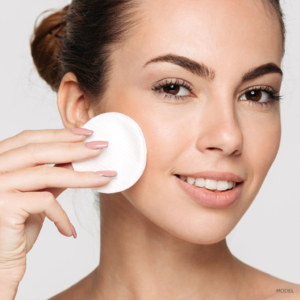Photoaging? Acne? Go for Some Glycolic Magic
If you’ve ever gone to an aesthetician, you’ve heard of glycolic acid. It’s the cornerstone of professional treatment plans addressing a wide range of skin concerns. In both clinical-grade facial peels and over-the-counter home care, glycolic acid is prized for its ability to even out skin tone, reverse sun damage, minimize wrinkles, clear up acne and more.
Before running out to buy an intense glycolic acid facial cream, however, first take a moment to get acquainted. A little knowledge and you can make glycolic acid your secret power in the pursuit of clear, radiant, more youthful skin.
Skin Candy
Glycolic is an alpha hydroxy acid (AHA) derived from cane or beet sugar. Most famous as an exfoliant, it also functions as an anti-inflammatory and skin thickener. What gives it an edge over other AHAs is its molecule size, which is tiny enough to penetrate into deeper levels of skin. Working from your skin’s surface (stratum corneum) down to the underlying dermis, glycolic acid sloughs off dead cells and stimulates production of fresh cells.
By clearing away the old, glycolic makes new skin more receptive to the beautifying effects of other treatments like Retin-A or a good vitamin C serum. Just be aware that glycolic acid can neutralize the efficacy of some types of vitamin C, so wear these ingredients at separate times. And if you want to add a strong retinoid like Retin-A to your regimen, first make sure your skin can handle it — Retin-A and glycolic together can be amazing, but intense!
Glycolic vs. Signs of Aging
It’s no secret that the sun is responsible for the lion’s share of visible skin aging: wrinkles, rough skin, discoloration, and lost firmness, volume and elasticity. In fact, the Skin Cancer Foundation attributes 90% of the signs of skin aging to sunlight!
Glycolic battles photoaging by causing your skin to cast off old, dead cells while also spurring production of young, organized ones. At the outer layer, this translates into removal of roughness, hyperpigmentation and dull skin. At a deeper layer, glycolic stimulates fibroblasts to create new collagen, which adds volume and spring to your skin. Glycolic action at both skin depths also diminishes fine lines and wrinkles.
When it comes to the sun’s effects on skin, it’s important to understand that glycolic acid has a mixed relationship with UV damage. A high-quality glycolic product or professional glycolic peels can help reverse many of the signs of photoaging. However, glycolic acid also leaves your skin more vulnerable to new sun damage. It’s up to you to make glycolic work for you, not against you. Avoid sun exposure and regularly apply a high-quality sunscreen with minimum 30 SPF as though your beautiful skin depended on it (because it does!).
Glycolic vs. Acne and Blemishes
 Perhaps you’ve seen the countless testimonials all over forums, social media and magazines. They feature users attesting to how glycolic reduced or fully banished their acne and also related blemishes. And it’s true: glycolic acid is an excellent active for clearing up an acneic complexion.
Perhaps you’ve seen the countless testimonials all over forums, social media and magazines. They feature users attesting to how glycolic reduced or fully banished their acne and also related blemishes. And it’s true: glycolic acid is an excellent active for clearing up an acneic complexion.
The primary way glycolic combats acne is through its powers of exfoliation. It loosens and removes any accumulated dead cells that are congesting skin, both at the surface and down inside the pores. One advantage glycolic offers over physical methods of exfoliation, like scrubs or microdermabrasion, is that there’s no abrasion to potentially inflame sensitive, acneic skin.
Some of the best products for acne pair glycolic with its cousin, the beta hydroxy acid (BHA) salicylic acid. As an AHA, glycolic is water soluble, but salicylic is oil soluble. This enables salicylic acid to gain easy entry into pores clogged by oily sebum, opening the way for glycolic to better penetrate and clear out the dead skin. This salicylic-glycolic synergy makes the products very effective at lower concentrations, which also decreases the likelihood of irritation.
Once your skin has developed some tolerance, ramp up your anti-acne offensive with regular clinical glycolic peels. Aim for a strength of 20% to 50%. Treatments at these higher acid concentrations have a pH low enough to bring intense antibacterial action into acneic pores. They’re great at stamping out bacterium C. acnes, warding off infection and calming inflammation.
Whether you suffer from chronic acne or just the occasional breakout, the key with glycolic is to go slowly. You’ll see optimal results, without inflammation. If you have severe or chronic acne, make an appointment with a board-certified dermatologist for an assessment and a personalized treatment plan.
Baby Steps to Baby Skin
 How do you start improving your skin’s appearance with glycolic acid? The best kickoff is to consult a dermatologist or aesthetician for a treatment plan. Then, slowly and vigilantly is typically how you should proceed in order to maximize the benefits of glycolic while minimizing irritation:
How do you start improving your skin’s appearance with glycolic acid? The best kickoff is to consult a dermatologist or aesthetician for a treatment plan. Then, slowly and vigilantly is typically how you should proceed in order to maximize the benefits of glycolic while minimizing irritation:
- Phase 1 — Start out by conditioning your skin to glycolic using a mild glycolic OTC face cream or a medium-strength, rinse-off cleanser. If you have sensitive or reactive skin or you’re new to the world of peels, stay on close watch. If you experience any stinging, irritation or an avalanche of peeling, reduce product strength or frequency of use. At this stage, consider booking an aesthetician for some gentle to medium-strength glycolic peels.
- Phase 2 — When your skin no longer responds adversely to your glycolic products, gradually move up the intensity. Try shifting to serums or creams with up to 10% glycolic acid, going much gentler in the delicate eye area. The first time at this higher strength, be ready to wash it off in case it stings. Begin with your product one to three nights per week, then little by little work your way up to applying it daily.
- Phase 3 — At this point, your skin and glycolic are good friends. You’re confident you’ve built up enough tolerance to handle strong treatments. You can now use clinical-grade glycolic products nightly and go for more frequent glycolic peels from an aesthetician. The more concentrated and frequent the peels, the farther they deliver benefits into skin. Want to go more aggressive, but aren’t ready for facelift surgery or a laser procedure like Fraxel? See a board-certified dermatologist about adding Retin-A or a potent retinol product to the mix.
If at any point you see irritation, take a break from glycolic acid and switch to only products formulated to coddle sensitive skin. However, if you approach glycolic with enough patience, good information and professional guidance, you’ll only see smoother, clearer, magically luminous skin.
* Individual results may vary and are not guaranteed.

 / 291 Reviews
/ 291 Reviews